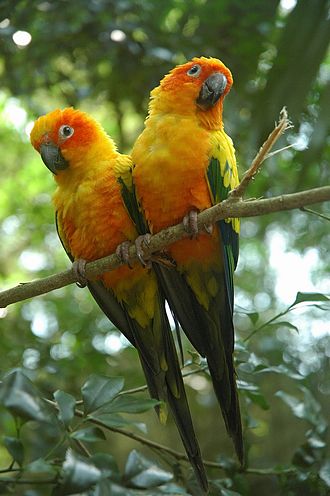Type the name of the breed you're looking for below
[wpdreams_ajaxsearchlite] Don't see the breed your're looking for? Click here and let us know!
Sun Conure
| Origin | The Sun Parakeet or Sun Conure occurs only in a relatively small region of north-eastern South America: the north Brazilian state of Roraima, southern Guyana, extreme southern Suriname, and southern French Guiana. It also occurs as a vagrant to coastal French Guiana. Its status in Venezuela is unclear, but there are recent sightings from the south-east near Santa Elena de Uairén. |
| Size | Can grow up to 12 in(30 cm) |
| Lifespan | Can live 15+ years |
| Noise | High. Talkative birds. |
| Characteristics | Adults have a rich yellow crown, nape, mantle, lesser wing-coverts, tips of the greater wing-coverts, chest, and underwing-coverts. The face and belly are orange with red around the ears. The base of the greater wing-coverts, tertials, and base of the primaries are green, while the secondaries, tips of the primaries, and most of the primary coverts are dark blue. The tail is olive-green with a blue tip. From below, all the flight feathers are dark greyish. The bill is black. The legs and the bare eye-ring are grey, but the latter often fades to white in captivity. |
| Abilities | Can be taught to mimic human speech. Some species can learn up to 500 words. |
| Interaction/Time Requirements, Diet, Supplies Needed | Parrots are escape artists, be sure to secure the cage or aviary. Aviaries are sold ready for home assembly. Parrots can also be hand reared, provided that they have a large cage and are taken out of their cage on a daily basis to prevent boredom, as it may result in the parrot pulling out its feathers to occupy itself. Parrots do well in aviaries and/or cages. They don't like to be in crowded spaces and will sometimes be aggressive towards other birds if they don't have enough space. They require a warm habitat for the winter months. Do not allow your birds outdoors until all signs of frost are gone. Space is important and indoor cages should be as large as possible. A large cage is required even if the bird is going to spend lots of time out of its habitat with you. They eat a foreign seed mixture that contains various millets and other small seeds such as niger, pellets, fruits, and vegetables. You need to change food and water twice daily, and clean the cage at least once a day, replacing toys and broken climbing branches. |



